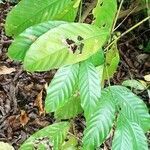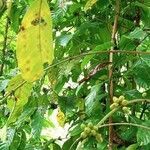Small trees or shrubs, 4-8 m tall; branches flattened becoming subterete, glabrous. Petiole 10-20 mm, glabrous; leaf blade drying thickly papery, elliptic, elliptic-oblong, or occasionally ovate-oblong, (12-)15-30(-40) × (4.5-)6-12(-22) cm, glabrous on both surfaces, base cuneate to obtuse, margins flat or occasionally crisped-undulate, apex acuminate with tip 10-18 mm; secondary veins (8-)10-12(-17) pairs, without domatia or with glabrous foveolate domatia; stipules triangular, 6-18 mm, obtuse to acute, aristate. Inflorescences with cymes 1-3(-7) in each axil, each cyme subcapitate to fasciculate, 3-6-flowered, subsessile to pedunculate with peduncles to 7 mm; bracts cupular, 1-3 mm; pedicels to 2 mm. Calyx glabrous; ovary portion ellipsoid, 1-2 mm; limb reduced or denticulate, 0.1-0.5 mm. Corolla white to pink, funnelform, outside glabrous; tube 5-16 mm; lobes (4 or)5-7(or 8), spatulate to narrowly elliptic, 8-19 mm, obtuse to rounded. Drupe red, subglobose, 10-12 × 10-12 mm, smooth when dry, glabrous. Fl. Apr-Jun, fr. Oct-Dec.
A larger tree than Arabica coffee. It is an evergreen shrub. It grows to 10 m tall and has thicker, larger leaves. It is shallow rooted with most feeding in the top 12 cm of soil. In heavy shade, trees have a more developed trunk. The leaves are 15-30 cm long by 5-15 cm wide, and rounded at the base, with wavy edges. The midrib is prominent underneath the leaf. There are 8-13 pairs of side veins. The leaf stalk is stout and 1-2 cm long. The flower clusters arise in the axils of leaves on sideways growing, fruiting branches. Normally only 3-4 buds develop in each leaf axils and 2-4 flowers develop on each flower stalk. The flowers are white and have a scent. The flowers have almost no stalk. The fruit are round and 0.8-1.5 cm long by 1.2 cm wide. The fruit are green, but turn red when ripe. They turn black and remain on the tree till harvest. 20-40 fruit can develop at each node. The seed are 7-9 mm long, and flattened on the surface which is pressed together.
An evergreen shrub or small tree, to 20 ft. high
Also cultivated
Flowers white.



